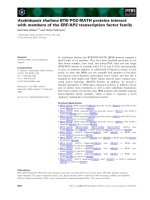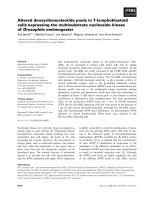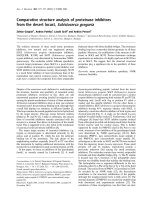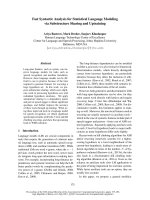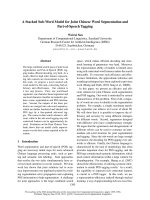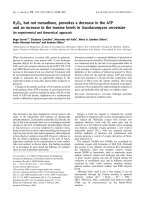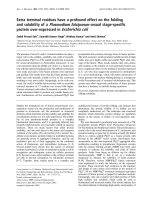Báo cáo khoa học: Comparative proteomic analysis identifies proteins associated with the development and progression of colorectal carcinoma pot
Bạn đang xem bản rút gọn của tài liệu. Xem và tải ngay bản đầy đủ của tài liệu tại đây (472.74 KB, 10 trang )
Comparative proteomic analysis identifies proteins
associated with the development and progression
of colorectal carcinoma
Liang Zhao
1,2,
*, Hui Wang
3,
*, Xuegang Sun
4
and Yanqing Ding
1
1 Department of Pathology, Nanfang Hospital, Southern Medical University, Guangzhou, China
2 Department of Pathology, School of Basic Medical Sciences, Southern Medical University, Guangzhou, China
3 Department of Medical Oncology, Affiliated Tumor Hospital of Guangzhou Medical College, China
4 School of Traditional Chinese Medicine, Southern Medical University, Guangzhou, China
Introduction
Colorectal cancer (CRC) is the third most common
cancer worldwide in both men and women, especially
in ageing populations. It ranks third as the cause of
death from carcinoma, surpassed only by lung and
prostate neoplasms in men, and lung and breast can-
cers in women [1,2]. As in most malignant diseases,
early diagnosis and especially detection of metastases
are of importance for patient prognosis. Presently,
clinical parameters combined with histopathological
staging and grading are the most important diagnostic
and prognostic variables. The evaluation of carcino-
embryonic antigen in serum has not fulfilled the prom-
ise of a simple test that would offer early diagnosis of
colon cancer. A number of other, less well-explored,
potential markers exist, but are currently not used in
routine clinical diagnosis [3–5]. Therefore, more exten-
sive proteome tests are desirable for diagnosis, progno-
sis evaluation and monitoring recurrent disease.
Using the technologies of two-dimensional electro-
phoresis ⁄ MS and immunohistochemistry in combina-
tion, the aim of this study was to investigate the
genesis- and metastasis-associated proteins, and to
Keywords
carcinogenesis; colorectal carcinoma;
proteomics; tumour progression;
two-dimensional electrophoresis
Correspondence
Y. Ding, Department of Pathology, Nanfang
Hospital, Southern Medical University,
Guangzhou, China
Fax ⁄ Tel: +86 20 61642148
E-mail:
*These authors contributed equally to this
paper
(Received 9 April 2010, revised 1 July 2010,
accepted 5 August 2010)
doi:10.1111/j.1742-4658.2010.07808.x
To better understand the mechanism underlying colorectal carcinoma
(CRC) genesis or metastasis, and to search for potential markers for CRC
prognosis, a comparative proteomic analysis was performed on CRC tissue.
Proteins were extracted from normal colorectal mucosa, non-metastatic
CRC (nmCRC) and metastatic CRC (mCRC) tissue samples. Protein pro-
filing of each sample was performed by two-dimensional electrophoresis
coupled with MALDI-TOF MS, followed by confirmation by Western
blotting. Thirty-one proteins were found to be differentially expressed
between normal mucosa, nmCRC and mCRC tissue. In 126 paraffin-
embedded CRC samples, three differentially expressed proteins, identified
as LASP-1, S100A9 and RhoGDI by proteomic analysis, were detected by
immunohistochemical staining to determine the clinicopathological charac-
teristics of these proteins in CRC. Increased expression levels of these
proteins were found in CRC, especially mCRC, compared with normal
mucosa. The results provide the basis for searching for potential markers
for CRC genesis and metastasis, and also provide clues for elucidating the
mechanism of CRC progression. The pattern changes identified have the
potential to be used for the design of marker panels for assistance in diag-
nostic and therapeutic strategies in CRC.
Abbreviations
CRC, colorectal carcinoma; mCRC, metastatic colorectal carcinoma; nmCRC, non-metastatic colorectal carcinoma.
FEBS Journal 277 (2010) 4195–4204 ª 2010 The Authors Journal compilation ª 2010 FEBS 4195
evaluate the correlation between clinicopathological
characteristics of CRC and expression of these target
proteins, in order to better understand the mechanisms
underlying CRC progression.
Results
Differential protein expression among normal
colorectal mucosa, nmCRC and mCRC tissue
A total of 1107 ± 27, 1130 ± 23 and 1135 ± 28 pro-
tein spots were visualized in two-dimensional gels
using image analysis software. Compared with the nor-
mal tissue control, the mCRC and nmCRC groups
had average matching rates of 70.2% and 72.6%. To
identify a CRC genesis-specific protein expression pat-
tern, comparative two-dimensional analysis of normal
tissue and primary CRC tissue samples was performed.
pdquest software analysis identified 22 spots that
were present in both CRC groups but not in the nor-
mal tissue. With regard to determination of a CRC
metastasis-specific protein expression pattern, compar-
ative proteomic analysis identified 11 proteins exhibit-
ing consistent up-regulated expression in mCRC
compared with nmCRC. Three representative gel
images for each group are shown in Fig. S1. All the
protein spots of interest were successfully identified by
MALDI-TOF MS (Fig. 1), and by subsequent com-
parative sequence searches in the Mascot database
(Table 1). The MSDB identification number, the theo-
retical molecular mass, the theoretical pI, the sequence
coverage and the MASCOT score are shown in
Table 1. Among them, the three proteins, identified as
Rho GDP dissociation inhibitor alpha (RhoGDI),
S100A9 and LIM and SH3 protein 1 (LASP-1), were
found to be significantly up-regulated in tumour tissue
specimens, especially in metastatic CRC. Enlarged
images of the three protein spots are shown in
Fig. 2A.
Validation of the identify of differentially
expressed proteins by Western blotting
To confirm and extend the two-dimensional electro-
phoresis results, Western blotting was used to confirm
that expression of RhoGDI, S100A9 and LASP-1 was
significantly higher in mCRC tissue than in the
nmCRC group, while the normal tissue had the lowest
expression. Equal protein loading was confirmed by
parallel GAPDH immunoblotting, and signal quantifi-
cation was performed by densitometric scanning. A
representative Western blotting result is shown in
Fig. 2B.
Immunohistochemical analysis
Expression and subcellular localization of proteins was
determined by immunohistochemistry in paraffin-
embedded normal colorectal mucosa and CRC tissues.
A representative immunohistochemistry staining is
shown in Fig. 3. The rates of RhoGDI, S100A9 and
LASP-1 over-expression in normal mucosa, nmCRC
and mCRC tissue are shown in Table 2. Statistical
analysis demonstrated that the mCRC samples had sig-
nificantly higher positive over-expression rates of Rho-
GDI, S100A9 and LASP-1 than the nmCRC samples
(Table 2). However, there was no significant correla-
tion between the three profiles (P > 0.05).
Discussion
In the present study, 31 proteins were identified as
differentially expressed among normal colorectal
mucosa, nmCRC and mCRC. To some extent, this
result is consistent with data reported by other
groups [2,6–9], who listed several proteins involved in
protein synthesis and folding (heat shock proteins),
cell communication and signal transduction (annexin),
cellular reorganization and the cytoskeleton (tropo-
myosin, tubulin and actin) and toxin catabolism and
water deprivation (glutathione transferase) in proteo-
mic profiles of CRC cell lines and tissue. However,
Fig. 1. Two-dimensional gel pattern showing all the spots identified
(1–31). Table 1 gives the identities of the protein.
Proteins with the genesis and progression of CRC L. Zhao et al.
4196 FEBS Journal 277 (2010) 4195–4204 ª 2010 The Authors Journal compilation ª 2010 FEBS
there are some differences between our data and that
of other researchers, such as differential expression of
RhoGDI and LASP-1. We consider that two-dimen-
sional electrophoresis and MALDI-TOF MS-based
peptide mass fingerprinting analysis of human tissues
is more complex than for cell lines. It is difficult for
a single laboratory to fully analyze extensive biological
information that are generated by two-dimensional
electrophoresis. Systemic collection and analysis of
complementary data from various research groups
will assist in producing global protein profiles of
CRC. Moreover, differences between races and region
distributions, as well as the various methods of tissue
collection and processing, may contribute to the dif-
ferences between laboratories. The methods used in
this study, involving tissue washing and surface
scraping of tissue, are important in order to collect
pure tumour cell populations that are free of con-
taminating serum proteins, red blood cells, connective
tissue and necrotic tissue [10].
The 31 spots representing differentially expressed
proteins among normal colorectal mucosa, nmCRC
and mCRC were excised from the two-dimensional
electrophoresis gels for subsequent analysis in this
study. All these spots were successfully identified.
The Western blotting results confirmed our proteomic
identification of the proteins RhoGDI, S100A9 and
LASP-1, showing elevated expression in the case of
CRC, especially mCRC, compared with normal colo-
rectal mucosa. Immunohistochemical analysis revealed
that over-expression of the three proteins was signifi-
cantly associated with the genesis and progression of
CRC. The functional implications of the alterations in
the levels of these proteins are discussed in detail.
Table 1. The 31 proteins differentially expressed among normal colorectal mucosa, nmCRC and mCRC tissue.
Protein
index
Theoretical
M
r
(kDa) ⁄ pI
Summary
score
Protein
coverage
(%) MSDB ID Protein description
Protein level
(tumour ⁄
normal)
Protein level
(mCRC ⁄
nmCRC)
1 52 200 ⁄ 5.35 101 30 Q5SP14 Heat shock 70 kDa protein 1B Down –
2 48 599 ⁄ 5.6 186 62 S37780 Keratin 20, type I-like, cytoskeletal Down –
3 58 339 ⁄ 7.95 117 39 KPYM Pyruvate kinase, isozymes M1 ⁄ M2 Down –
4 68 354 ⁄ 5.67 146 45 E973181 a-fetoprotein Down –
5 53 580 ⁄ 5.62 115 27 Q53HF2 Heat shock 70 kDa protein 8,
isoform 2 variant
Down –
6 41 973 ⁄ 6.69 101 44 1HJOA Heat-shock 70 kDa protein,
42 kDa fragment
Down –
7 20 146 ⁄ 6.76 127 70 CYHUAB a-crystallin chain B Down –
8 68 354 ⁄ 5.67 109 27 E973181 a-fetoprotein Down –
9 12 312 ⁄ 6.95 73 84 Q59FA5 Transgelin variant Down Up
10 58 339 ⁄ 7.95 205 50 KPYM Pyruvate kinase, isozymes M1 ⁄ M2 Up –
11 29 678 ⁄ 5.5 139 65 Q6PJ43 ACTG1 protein Up –
12 56 577 ⁄ 8.54 71 32 FGHUB Fibrinogen b chain precursor Up –
13 42 568 ⁄ 5.72 76 40 A36898 Maspin Up –
14 30 185 ⁄ 6.11 118 42 S68234 LASP-1 protein Up –
15 28 769 ⁄ 6.75 137 60 PGAM1 Phosphoglycerate mutase 1 Up –
16 30 337 ⁄ 8.81 72 26 Q7KZ74 A+U-rich element RNA binding factor Up –
17 23 108 ⁄ 5.21 82 37 1YER Heat shock protein 90 Up –
18 36 393 ⁄ 5.63 137 49 ANXA3 Annexin A3 Up –
19 12 770 ⁄ 5.55 71 80 CAA00999 Calgranulin B Up –
20 28 512 ⁄ 5.19 107 46 PSA3 Proteasome subunit a, type 3 Up –
21 48 135 ⁄ 4.7 76 31 Q5JP53 Tubulin, b polypeptide Up –
22 20 571
⁄ 6.73 96 53 1CC0E Rho GDP dissociation inhibitor a, chain E Up Up
23 40 270 ⁄ 4.89 79 28 Q6PK50 Heat shock 90kDa protein 1, Beta (HSPCB) – Up
24 33 027 ⁄ 4.63 105 60 A23562 Tropomyosin 1, fibroblast and epithelial cell – Up
25 34 980 ⁄ 4.81 117 57 T08796 Tropomyosin – Up
26 35 224 ⁄ 5.14 183 70 1HVG Annexin V – Up
27 7707 ⁄ 9.88 75 85 Q5KSY4 CC chemokine receptor 5 (fragment) – Up
28 23 444 ⁄ 5.42 111 56 A41177 Glutathione transferase – Up
29 19 697 ⁄ 4.84 84 41 S06590 IgE-dependent histamine-releasing factor – Up
30 22 826 ⁄ 5.98 127 68 HHHU27 Heat shock protein 27 – Up
31 20 155 ⁄ 5.25 85 39 1QINA Lactoylglutathione lyase – Up
L. Zhao et al. Proteins with the genesis and progression of CRC
FEBS Journal 277 (2010) 4195–4204 ª 2010 The Authors Journal compilation ª 2010 FEBS 4197
Rho GDIs (GDP dissociation inhibitors) have been
identified as key regulators of Rho family GTPases,
which are typified by their ability to prevent nucleotide
exchange and membrane association. These function by
extracting Rho family GTPases from membranes and
solubilizing them in the cytosol. Moreover, they interact
only with prenylated Rho proteins both in vitro and
in vivo [11,12]. They also inhibit nucleotide exchange
and GTP-hydrolyzing activities on Rho proteins by
interacting with their switch regions and probably
restricting accessibility to guanine exchange factors
(GEFs) and GTPase-activating proteins (GAPs). We
used comparative proteomic analysis to identify a mem-
ber of the GDI family, namely RhoGDI, that is up-reg-
ulated in metastatic CRC, in agreement with results
obtained previously [13]. Despite the initial negative
roles attributed to RhoGDI, recent evidence suggests
that it may also act as a positive regulator that is neces-
sary for correct targeting and regulation of Rho activi-
ties by conferring cues for spatial restriction, guidance
and availability to effectors [14,15]. For example, Rac1
regulation of NADPH oxidase activity in neutrophils
may require formation of a protein complex with
RhoGDI [16–18]. Similarly, Ras guanine nucleotide-
releasing factor (RasGRF)-induced mitogen-activated
protein kinase activation and Cdc42-mediated cellular
transformation [2] may require formation of a complex
between the respective GTPases and RhoGDI [19]. It
also appears that RhoGDI can serve as an escort to
shuttle Rho GTPases to membrane-associated signalling
complexes, which is crucial for coupling the GTPases
to their downstream effector proteins [20]. In a
AB
C
D
Fig. 2. Identification and further validation of differentially expressed protein spots. (A) Peptide mass fingerprinting of protein spots 14, 19
and 22, representing RhoGDI, S100A9 and LASP-1, respectively. (B) Enlarged images of RhoGDI, S100A9 and LASP-1 in two-dimensional
gels of normal colorectal mucosa, nmCRC and mCRC. (C) Protein expression of RhoGDI, S100A9 and LASP-1 in normal tissue, nmCRC and
mCRC determined by Western blotting. There are three representative samples in each group, and the results show that expression of Rho-
GDI, S100A9 and LASP-1 significantly increases in the nmCRC group. GAPDH is used as an internal loading control. (D) Immunosignals were
quantified by densitometric scanning. Protein expression in the individual tissue samples was calculated as protein expression relative to
GAPDH expression. Data are means ± SD from three independent experiments. *P < 0.05 compared with protein expression in normal
mucosa; **P < 0.05 compared with protein expression in nmCRC.
Proteins with the genesis and progression of CRC L. Zhao et al.
4198 FEBS Journal 277 (2010) 4195–4204 ª 2010 The Authors Journal compilation ª 2010 FEBS
comparative proteomic analysis of non-invasive versus
invasive ovarian tumours, RhoGDI was found to be
over-expressed in invasive human ovarian cancer com-
pared to non-invasive cancer [21]. All these results indi-
cate that RhoGDI may play an important role in the
progression and metastasis of CRC.
The S100A9 protein, formerly called calgranulin B,
MRP14 or LI heavy chain, is a protein of about
13 kDa that can occur in three different isoforms
depending on its level of phosphorylation [22]. This
protein is found predominantly in the cytosol, but can
also be expressed on the cell surface or even secreted
into the extracellular environment. The best character-
ized intracellular function proposed for S100A9 is that
of inhibition of casein kinase II, contributing to
regulation of normal cellular transcription and transla-
tion. The possible extracellular functions assigned to
S100A9 include chemotactic activity on the one hand
and cytotoxic ⁄ cytostatic activities against bacteria,
fungi and tumour cells on the other hand [23].
Previous studies have reported that S100A8 and
S100A9 are frequently co-expressed, and their expres-
sion appears to be coordinately regulated [24,25]. Dif-
ferential expression of S100A8 and S100A9 has been
shown to contribute to the development and progres-
sion of various types of cancer. For example, S100A8
and S100A9 are over-expressed in pancreatic adenocar-
cinoma [26], bladder cancers [27] and breast cancers
[28]. S100A9 expression is linked to de-differentiation
of thyroid carcinoma [29]. Several studies have
attempted to correlate the level of expression of
S100A8 and S100A9 with the degree of non-inva-
sive ⁄ invasive behaviour. Non-invasive MCF-7 breast
cancer cells do not express S100A9. S100A9 expression
in MCF-7 is induced by the cytokine oncostatin m
through the STAT3 signalling cascade [30]. However,
both S100 proteins are highly expressed in non-inva-
sive MDA-MB-468 cells [31]. The invasive breast can-
cer cell line MDA-MB-231 shows only a low transcript
level of S100A9 [32], but S100A9 is over-expressed in
invasive ductal carcinoma of the breast [1,33]. S100A8
and S100A9 have been suggested to represent novel
Fig. 3. Immunohistochemical staining of
RhoGDI, S100A9 and LASP-1 in normal
colorectal mucosa, nmCRC and mCRC.
Immunoreactivity to RhoGDI, S100A9 and
LASP-1 staining was localized to the
cytoplasm region of benign and malignant
epithelial cells.
Table 2. Over-expression of RhoGDI, S100A9 and LASP-1 proteins in normal mucosa, nmCRC and mCRC.
Group
RhoGDI (%) S100A9 (%) LASP-1 (%)
Low High Low High Low High
Normal 52 (88.1) 7 (11.9) 48 (75.0) 16 (25.0) 58 (82.9) 12 (17.1)
nmCRC 61 (76.3) 19 (23.7) 55 (68.8) 25 (31.2) 62 (77.5) 18 (22.5)
mCRC 22 (47.8) 24 (52.2) 19 (41.3) 27 (58.7) 23 (50.0) 23 (50.0)
a
v value 22.062 14.462 16.603
a
P value < 0.001 0.001 < 0.001
a
The statistical analyses were performed among normal mucosa, nmCRC and mCRC groups.
L. Zhao et al. Proteins with the genesis and progression of CRC
FEBS Journal 277 (2010) 4195–4204 ª 2010 The Authors Journal compilation ª 2010 FEBS 4199
diagnostic markers when measured in the serum of
patients with prostate cancer and benign prostate
hyperplasia [34]. In line with these observations, we
detected up-regulated expression of S100A9 proteins in
CRC tissues, especially in mCRC, indicating its possi-
ble role in the development and progression of CRC.
LASP-1 was initially identify from a cDNA library
of metastatic axillary lymph nodes of breast cancer
patients, and the gene was mapped to human chromo-
some 17q21 [35,36]. The exact functions of LASP-1 are
still not well known; however, its expression is local-
ized to multiple sites of dynamic actin assembly, such
as focal contacts, focal adhesions, lamellipodia mem-
brane ruffles and pseudopodia [30,35,37–39]. It has
been reported that LASP-1 is over-expressed in meta-
static breast cancer, participating in migration of these
cancer cells. Furthermore, silencing of LASP-1 in met-
astatic breast cancer cell lines resulted in strong inhibi-
tion of cell proliferation as well as migration, and led
to a reduction of zyxin at the focal contacts [30,40].
Interestingly, a recent study also demonstrated that
LASP-1 is over-expressed in ovarian cancer tissues and
metastatic ovarian cancer cell lines [41]. In vitro silenc-
ing of the gene encoding LASP-1 reduced cell prolifer-
ation and migration and severely affected zyxin
localization [41]. These results indicate that LASP-1
may play an important role in the progression and
metastasis of CRC.
In summary, the techniques of proteomic analysis
provide a dramatic means of screening for genesis- and
metastasis-associated proteins in CRC. The results sug-
gest that RhoGDI, S100A9 and LASP-1 may play an
important role in the development and progression of
CRC. Further functional and clinical analysis of the
proteins is necessary to elucidate their precise role in
the process of CRC and the formation of metastases.
Experimental procedures
Tumour samples
All cases were selected from the Nanfang Hospital tumour
tissue bank. In total, 150 patients were involved in the
study. In each case, a diagnosis of primary CRC had been
made, and the patients had undergone elective surgery for
CRC, in Nanfang Hospital, between 2001 and 2004. The
Nanfang Hospital tumour tissue bank is linked to a com-
prehensive set of clinicopathological data. Clinical data for
all the samples used for two-dimensional electrophoresis
and immunohistochemical study are shown in Table 3. The
tumour samples were submitted to the Department of
Pathology, Nanfang Hospital, Southern Medical Univer-
sity, for pathological diagnosis. The tumour specimens were
fixed in formalin, representative blocks were embedded in
wax, and sections were stained with haematoxylin and
eosin. Permission for this study was obtained from the Eth-
ics Committee of Southern Medical University. The
informed consent with a uniform format was designed by
the Ethics Committee and signed by the patients involved
in the study before the trial. All the patients understood the
trial’s purpose and procedures.
Proteomics
Proteomics analysis, including two-dimensional gel electro-
phoresis, gel visualization and assessment, and mass spec-
trometry, was performed as previously described [42].
Proteins were extracted from normal colorectal mucosa
(n = 12), non-metastatic CRC (nmCRC) (n = 12) and
metastatic CRC (mCRC) (n = 12) tissue samples. Tissue
samples (50–100 mg) were crushed in liquid nitrogen, and
lysed in 1 mL lysis buffer consisting of 7 m urea, 2 m thio-
urea, 4% Chaps, 65 mm dithiothreitol and 2% pharmalyte
(pH3-10; GE Healthcare, Piscataway, NJ, USA) by sonica-
tion on ice. The lysates were cleared by centrifugation at
12 000 g for 1 h at 4 °C. The protein concentration of the
supernatants was determined by the modified Bradford
method [43], and aliquots of the protein samples were
stored at )80 °C. Prior to two-dimensional electrophoresis,
the protein samples were purified using a 2D Clean-Up kit
(GE Healthcare) according to the manufacturer’s instruc-
tions. Differentially expressed proteins were identified using
two-dimensional gel electrophoresis and mass spectrome-
try. Two-dimensional gel electrophoresis was performed
using Immoboline strips (pI range, 3–10; GE Healthcare,
Piscataway, NJ, USA), with proteins being separated
according to charge, and subsequently molecular weight.
The gels were then stained with silver in order to visualize
Table 3. CRC tissue samples used in the study.
Samples for two-dimensional electrophoresis Samples for immunohistochemisty
Normal nmCRC mCRC Normal nmCRC mCRC
Lymph node status – Negative Positive – Negative Positive
Number 12 12 12 Uncertain 80 46
Gender (male ⁄ female) 5 ⁄ 75⁄ 710⁄ 2 Unknown 52 ⁄ 28 27 ⁄ 19
Age (years, mean ± SD) 54 ± 17.9 52 ± 15.9 56 ± 14.7 Uncertain 54 ± 13.6 56 ± 14.8
Proteins with the genesis and progression of CRC L. Zhao et al.
4200 FEBS Journal 277 (2010) 4195–4204 ª 2010 The Authors Journal compilation ª 2010 FEBS
proteins, and scanned using a Power-Look 1100 imaging
scanner (Umax, Dallas, TX, USA). The pdquest 7.1 soft-
ware package (Bio-Rad, Hercules, CA, USA) was used for
image analysis, including background abstraction, spot
intensity calibration, spot detection and matching. The
intensity of each spot was quantified by calculation of spot
volume after normalization of the gel image. Each experi-
ment was performed in triplicate, and the paired Student’s
t test was used to evaluate the mean change in protein
abundance corresponding to each target spot across the
gels. The protein spots of interest were cut from the gels.
Proteins were digested with trypsin, and peptide mass
mapping was performed by MALDI-TOF MS using an
ABI Voyager DE-STR mass spectrometer (Applied Biosys-
tems, Foster City, CA, USA). Protein identification using
peptide mass fingerprinting was performed using the MAS-
COT search engine ( Matrix
Science Ltd, London, UK) against the MSDB protein
database (ht tp://www.proteomics.leeds.ac.uk/bioinf/msdb.
html). The database search was restricted to human pro-
teins, with no constraints on either the molecular weight
or the isoelectric point of the protein. The errors in pep-
tide mass were in the range of 25 ppm. One missed tryptic
cleavage site per peptide was allowed during the search.
Proteins matching more than four peptides and with a
MASCOT score higher than 63 were considered significant
(P < 0.05). Carboamidomethylation of cysteine was used
as the static modification and oxidation of methionine as
the differential modification. The protein identification
results were filtered using peakerazor software (Light-
house Data, Odense, Denmark).
Western blot analysis
Samples from the different population were selected for
Western blot validation. Sample preparation for immuno-
blotting was performed as previously described [44]. Briefly,
proteins were obtained from tissue samples as described
above. The protein concentration was determined using the
modified Bradford method [43]. Equal amounts of proteins
were separated electrophoretically on 12% SDS ⁄ polyacryl-
amide gels, and transferred onto polyvinylidene difluoride
membranes (PVDF) (Amersham Pharmacia Biotech, Piscat-
away, NJ, USA). The membrane was probed using rabbit
anti-RhoGDI IgG (1 : 1000; Cell Signalling Technology,
Danvers, MA, USA), mouse anti-S100A9 IgG (1 : 1000;
Abcam, Cambridge, UK) and mouse anti-LASP-1 IgG
(1 : 2000; Chemicon, Temecula, CA, USA). Expression of
proteins was determined using horseradish peroxidase-
conjugated anti-rabbit IgG (1 : 20 000; Jingmei Biotech,
Shanghai, China) and enhanced chemiluminescence (ECL)
(Pierce, Rockford, IL, USA). The immunoreactive bands
were visualized on a Kodak 2000M camera system (Eastman
Kodak, Rochester, NY, USA) according to the manufac-
turer’s instructions. An anti-GAPDH goat polyclonal IgG
(1 : 500; Santa Cruz Biotechnology, Santa Cruz, CA,
USA) was used to confirm equal loading. The experiments
were repeated three times.
Immunohistochemistry
Immunohistochemistry was performed to study altered pro-
tein expression in 126 human CRC tissue samples. The pro-
cedures used were similar to previously described methods
[44]. Briefly, 4 lm sections mounted on aminopropylethox-
ysilane slides and pre-treated for immunohistochemistry
were de-waxed using xylene, and rehydrated through a
graded series of ethanol and deionized water. An antigen
retrieval step was performed. Before staining for immuno-
histochemistry, the sections were incubated in a 750 W
microwave oven for 15 min in 10 mm buffered citrate, pH
6.0, to complete antigen unmasking. The classical avidin–
biotin peroxidase complex procedure was used for immuno-
histochemistry. In the avidin–biotin peroxidase complex
system, endogenous peroxidase was quenched by incubation
of the sections in 0.1% sodium azide with 0.3% hydrogen
peroxide for 30 min at room temperature. Non-specific
binding was blocked by incubation with non-immune serum
(1% bovine serum albumin for 15 min at room temperature).
The sections were incubated with primary anti-RhoGDI
(1 : 50), mouse anti-S100A9 (1 : 100) and anti-LASP-1
(1 : 500) antibodies overnight at 4 °C. The following con-
trols were performed: (a) omission of the primary
antibody, and (b) substitution of the primary antiserum
with non-immune serum diluted 1 : 500 in blocking buffer.
No immunostaining was observed after any of the control
procedures. Biotinylated secondary goat anti-rabbit anti-
bodies (MaiXin, Fuzhou, China) and subsequently a horse-
radish peroxidase–streptavidin complex (MaiXin) were
applied for 15 min each. Peroxidase activity was developed
by use of a filtered solution of 5 mg 3,3-diaminobenzideine
tetrahydrochloride (dissolved in 10 mL 0.05 m Tris buffer,
pH 7.6) and 0.03% H
2
O
2
. Mayer’s haematoxylin was used
for nuclear counterstaining. The sections were mounted
using a synthetic medium.
Evaluation of immunohistochemical staining
Two observers independently reviewed and assessed the cel-
lular localization and intensity of immunostaining in each
section. Staining for proteins in tumour cells was scored
semi-quantitatively using a quality control system. The pro-
portion of cells expressing the proteins varied from 0% to
100%, and the intensity of staining varied from weak to
strong. Scores representing the percentage of tumour cells
stained positive were as follows: 0% (absent), 1–5% (spo-
radic), 6–25% (local), 26–50% (occasional), 51–75%
(majority) and 76–100% (large majority). The intensity of
tumour cell staining was scored as 0 (no staining), 1 (weak
staining, light yellow), 2 (moderate staining, yellowish
L. Zhao et al. Proteins with the genesis and progression of CRC
FEBS Journal 277 (2010) 4195–4204 ª 2010 The Authors Journal compilation ª 2010 FEBS 4201
brown) and 3 (strong staining, brown). Using this method
of assessment as mentioned above, we evaluated the expres-
sion of proteins in benign colorectal mucosa and malignant
lesions as described previously [45]. Cut-off values were
chosen on the basis of a measure of heterogeneity. An
optimal cut-off value was identified. An intensity score of
‡ 2 with at least 50% of malignant cells showing positive
staining was used to classify tumours with high expression
(or over-expression), and < 50% of malignant cells with
staining or an intensity score < 2 identified tumours with
low expression. The small number of discrepancies (< 5%)
were resolved by re-evaluation.
Statistical analysis
All statistical analyses were performed using the spss 12.0
statistical software package (SPSS, Chicago, IL, USA). The
pdquest 7.1 software package (Bio-Rad) was used for
image analysis, and a paired Student’s t test was used to
evaluate the mean change in protein abundance corre-
sponding to each target spot across the gels. For Western
blot analysis, expression of differential protein between two
groups was compared using a paired Student’s t test. For
immunohistochemistry analysis, the significance of correla-
tion between the protein expression and clinicopathological
factors was determined using Pearson’s chi-square test. A P
value < 0.05 was considered statistically significant in all
cases.
Acknowledgements
This work was supported by the Key Science and
Technology Research Program of Guangdong Prov-
ince (grant number 2003A308401), the National Natu-
ral Science Foundation of China (grant number
30901792) and the Presidential Foundation of the
School of Basic Medical Sciences of Southern Medical
University (grant number JC0802).
References
1 Arai K, Teratani T, Kuruto-Niwa R, Yamada T &
Nozawa R (2004) S100A9 expression in invasive ductal
carcinoma of the breast: S100A9 expression in adeno-
carcinoma is closely associated with poor tumour differ-
entiation. Eur J Cancer 40, 1179–1187.
2 Bi X, Lin Q, Foo TW, Joshi S, You T, Shen HM, Ong
CN, Cheah PY, Eu KW & Hew CL (2006) Proteomic
analysis of colorectal cancer reveals alterations in meta-
bolic pathways: mechanism of tumorigenesis. Mol Cell
Proteomics 5, 1119–1130.
3 Srivastava S, Verma M & Henson DE (2001) Biomar-
kers for early detection of colon cancer. Clin Cancer
Res 7, 1118–1126.
4 Wallace HM & Caslake R (2001) Polyamines and colon
cancer. Eur J Gastroenterol Hepatol 13, 1033–1039.
5 Yeatman TJ & Chambers AF (2003) Osteopontin and
colon cancer progression. Clin Exp Metastasis 20, 85–90.
6 Alfonso P, Nunez A, Madoz-Gurpide J, Lombardia L,
Sanchez L & Casal JI (2005) Proteomic expression anal-
ysis of colorectal cancer by two-dimensional differential
gel electrophoresis. Proteomics 5, 2602–2611.
7 Lou J, Fatima N, Xiao Z, Stauffer S, Smythers G,
Greenwald P & Ali IU (2006) Proteomic profiling iden-
tifies cyclooxygenase-2-independent global proteomic
changes by celecoxib in colorectal cancer cells. Cancer
Epidemiol Biomarkers Prev 15, 1598–1606.
8 Skandarajah AR, Moritz RL, Tjandra JJ & Simpson
RJ (2005) Proteomic analysis of colorectal cancer:
discovering novel biomarkers. Expert Rev Proteomics 2,
681–692.
9 Soreide K, Nedrebo BS, Knapp JC, Glomsaker TB,
Soreide JA & Korner H (2009) Evolving molecular clas-
sification by genomic and proteomic biomarkers in
colorectal cancer: potential implications for the surgical
oncologist. Surg Oncol 18, 31–50.
10 Alaiya AA, Roblick UJ, Franzen B, Bruch HP & Auer
G (2003) Protein expression profiling in human lung,
breast, bladder, renal, colorectal and ovarian cancers.
J Chromatogr B Analyt Technol Biomed Life Sci
787, 207–222.
11 Faure J & Dagher MC (2001) Interactions between Rho
GTPases and Rho GDP dissociation inhibitor
(Rho-GDI). Biochimie 83, 409–414.
12 DerMardirossian C & Bokoch GM (2005) GDIs:
central regulatory molecules in Rho GTPase activation.
Trends Cell Biol 15, 356–363.
13 Tian T, Hao J, Xu A, Hao J, Luo C, Liu C, Huang L,
Xiao X & He D (2007) Determination of metastasis-
associated proteins in non-small cell lung cancer by
comparative proteomic analysis. Cancer Sci 98,
1265–1274.
14 Olofsson B (1999) Rho guanine dissociation inhibitors:
pivotal molecules in cellular signalling. Cell Signal 11,
545–554.
15 Dovas A & Couchman JR (2005) RhoGDI: multiple
functions in the regulation of Rho family GTPase activ-
ities. Biochem J 390, 1–9.
16 Di-Poi N, Faure J, Grizot S, Molnar G, Pick E &
Dagher MC (2001) Mechanism of NADPH oxidase
activation by the Rac ⁄ Rho-GDI complex. Biochemistry
40, 10014–10022.
17 Abo A, Pick E, Hall A, Totty N, Teahan CG & Segal
AW (1991) Activation of the NADPH oxidase involves
the small GTP-binding protein p21rac1. Nature 353,
668–670.
18 Bromberg Y, Shani E, Joseph G, Gorzalczany Y,
Sperling O & Pick E (1994) The GDP-bound form of
the small G protein Rac1 p21 is a potent activator
Proteins with the genesis and progression of CRC L. Zhao et al.
4202 FEBS Journal 277 (2010) 4195–4204 ª 2010 The Authors Journal compilation ª 2010 FEBS
of the superoxide-forming NADPH oxidase of
macrophages. J Biol Chem 269, 7055–7058.
19 Arozarena I, Matallanas D & Crespo P (2001)
Maintenance of CDC42 GDP-bound state by Rho-GDI
inhibits MAP kinase activation by the exchange factor
Ras-GRF. Evidence for Ras-GRF function being inhib-
ited by Cdc42-GDP but unaffected by CDC42-GTP.
J Biol Chem 276, 21878–21884.
20 Gandhi PN, Gibson RM, Tong X, Miyoshi J, Takai Y,
Konieczkowski M, Sedor JR & Wilson-Delfosse AL
(2004) An activating mutant of Rac1 that fails to inter-
act with Rho GDP-dissociation inhibitor stimulates
membrane ruffling in mammalian cells. Biochem J 378,
409–419.
21 Jones MB, Krutzsch H, Shu H, Zhao Y, Liotta LA,
Kohn EC & Petricoin EF III (2002) Proteomic analysis
and identification of new biomarkers and therapeutic
targets for invasive ovarian cancer. Proteomics 2 ,
76–84.
22 Guignard F, Mauel J & Markert M (1996) Phosphory-
lation of myeloid-related proteins MRP-14 and MRP-8
during human neutrophil activation. Eur J Biochem
241, 265–271.
23 Hessian PA, Edgeworth J & Hogg N (1993) MRP-8
and MRP-14, two abundant Ca
2+
-binding proteins of
neutrophils and monocytes. J Leukoc Biol 53, 197–204.
24 Marionnet C, Bernerd F, Dumas A, Verrecchia F,
Mollier K, Compan D, Bernard B, Lahfa M, Leclaire J,
Medaisko C et al. (2003) Modulation of gene expression
induced in human epidermis by environmental stress
in vivo. J Invest Dermatol 121, 1447–1458.
25 Teigelkamp S, Bhardwaj RS, Roth J, Meinardus-Hager
G, Karas M & Sorg C (1991) Calcium-dependent com-
plex assembly of the myeloic differentiation proteins
MRP-8 and MRP-14. J Biol Chem 266, 13462–13467.
26 Shen J, Person MD, Zhu J, Abbruzzese JL & Li D
(2004) Protein expression profiles in pancreatic adeno-
carcinoma compared with normal pancreatic tissue and
tissue affected by pancreatitis as detected by two-dimen-
sional gel electrophoresis and mass spectrometry.
Cancer Res 64, 9018–9026.
27 Yao R, Lopez-Beltran A, Maclennan GT, Montironi R,
Eble JN & Cheng L (2007) Expression of S100 protein
family members in the pathogenesis of bladder tumors.
Anticancer Res 27, 3051–3058.
28 Cross SS, Hamdy FC, Deloulme JC & Rehman I (2005)
Expression of S100 proteins in normal human tissues
and common cancers using tissue microarrays: S100A6,
S100A8, S100A9 and S100A11 are all overexpressed in
common cancers. Histopathology 46, 256–269.
29 Ito Y, Arai K, Ryushi, Nozawa R, Yoshida H, Tomoda
C, Uruno T, Miya A, Kobayashi K, Matsuzuka F et al.
(2005) S100A9 expression is significantly linked to
dedifferentiation of thyroid carcinoma. Pathol Res Pract
201, 551–556.
30 Li C, Zhang F, Lin M & Liu J (2004) Induction of
S100A9 gene expression by cytokine oncostatin M in
breast cancer cells through the STAT3 signaling
cascade. Breast Cancer Res Treat 87, 123–
134.
31 Boyd JH, Kan B, Roberts H, Wang Y & Walley KR
(2008) S100A8 and S100A9 mediate endotoxin-induced
cardiomyocyte dysfunction via the receptor for
advanced glycation end products. Circ Res 102,
1239–1246.
32 Nagaraja GM, Othman M, Fox BP, Alsaber R,
Pellegrino CM, Zeng Y, Khanna R, Tamburini P,
Swaroop A & Kandpal RP (2006) Gene expression
signatures and biomarkers of noninvasive and invasive
breast cancer cells: comprehensive profiles by repre-
sentational difference analysis, microarrays and
proteomics. Oncogene 25, 2328–2338.
33 Seth A, Kitching R, Landberg G, Xu J, Zubovits J &
Burger AM (2003) Gene expression profiling of ductal
carcinomas in situ and invasive breast tumors. Antican-
cer Res 23, 2043–2051.
34 Hermani A, Hess J, De Servi B, Medunjanin S,
Grobholz R, Trojan L, Angel P & Mayer D (2005)
Calcium-binding proteins S100A8 and S100A9 as novel
diagnostic markers in human prostate cancer. Clin
Cancer Res 11, 5146–5152.
35 Tomasetto C, Moog-Lutz C, Regnier CH, Schreiber V,
Basset P & Rio MC (1995) Lasp-1 (MLN 50) defines a
new LIM protein subfamily characterized by the associ-
ation of LIM and SH3 domains. FEBS Lett 373,
245–249.
36 Tomasetto C, Regnier C, Moog-Lutz C, Mattei MG,
Chenard MP, Lidereau R, Basset P & Rio MC (1995)
Identification of four novel human genes amplified and
overexpressed in breast carcinoma and localized to the
q11–q21.3 region of chromosome 17. Genomics 28,
367–376.
37 Chew CS, Parente JA Jr, Zhou C, Baranco E & Chen
X (1998) Lasp-1 is a regulated phosphoprotein within
the cAMP signaling pathway in the gastric parietal cell.
Am J Physiol 275, C56–C67.
38 Chew CS, Parente JA Jr, Chen X, Chaponnier C &
Cameron RS (2000) The LIM and SH3 domain-
containing protein, lasp-1, may link the cAMP signaling
pathway with dynamic membrane restructuring
activities in ion transporting epithelia. J Cell Sci 113,
2035–2045.
39 Chew CS, Chen X, Parente JA Jr, Tarrer S, Okamoto
C & Qin HY (2002) Lasp-1 binds to non-muscle
F-actin in vitro and is localized within multiple sites
of dynamic actin assembly in vivo. J Cell Sci 115,
4787–4799.
40 Grunewald TG, Kammerer U, Schulze E, Schindler D,
Honig A, Zimmer M & Butt E (2006) Silencing of
LASP-1 influences zyxin localization, inhibits
L. Zhao et al. Proteins with the genesis and progression of CRC
FEBS Journal 277 (2010) 4195–4204 ª 2010 The Authors Journal compilation ª 2010 FEBS 4203
proliferation and reduces migration in breast cancer
cells. Exp Cell Res 312, 974–982.
41 Grunewald TG, Kammerer U, Winkler C, Schindler D,
Sickmann A, Honig A & Butt E (2007) Overexpression
of LASP-1 mediates migration and proliferation of
human ovarian cancer cells and influences zyxin locali-
sation. Br J Cancer 96, 296–305.
42 Zhao L, Liu L, Wang S, Zhang YF, Yu L & Ding YQ
(2007) Differential proteomic analysis of human
colorectal carcinoma cell lines metastasis-associated
proteins. J Cancer Res Clin Oncol 133, 771–782.
43 Ramagli LS (1999) Quantifying protein in 2-D PAGE
solubilization buffers. Methods Mol Biol 112, 99–103.
44 Zhao L, Wang H, Li J, Liu Y & Ding Y (2008) Overex-
pression of Rho GDP-dissociation inhibitor alpha is
associated with tumor progression and poor prognosis
of colorectal cancer. J Proteome Res 7, 3994–4003.
45 Coppola D, Szabo M, Boulware D, Muraca P, Alsarraj
M, Chambers AF & Yeatman TJ (2004) Correlation of
osteopontin protein expression and pathological stage
across a wide variety of tumor histologies. Clin Cancer
Res 10, 184–190.
Supporting information
The following supplementary material is available:
Fig. S1. Three representative gel images of normal
tissue, mCRC and nmCRC.
This supplementary material can be found in the
online version of this article.
Please note: As a service to our authors and readers,
this journal provides supporting information supplied
by the authors. Such materials are peer-reviewed and
may be re-organized for online delivery, but are not
copy-edited or typeset. Technical support issues arising
from supporting information (other than missing files)
should be addressed to the authors.
Proteins with the genesis and progression of CRC L. Zhao et al.
4204 FEBS Journal 277 (2010) 4195–4204 ª 2010 The Authors Journal compilation ª 2010 FEBS
